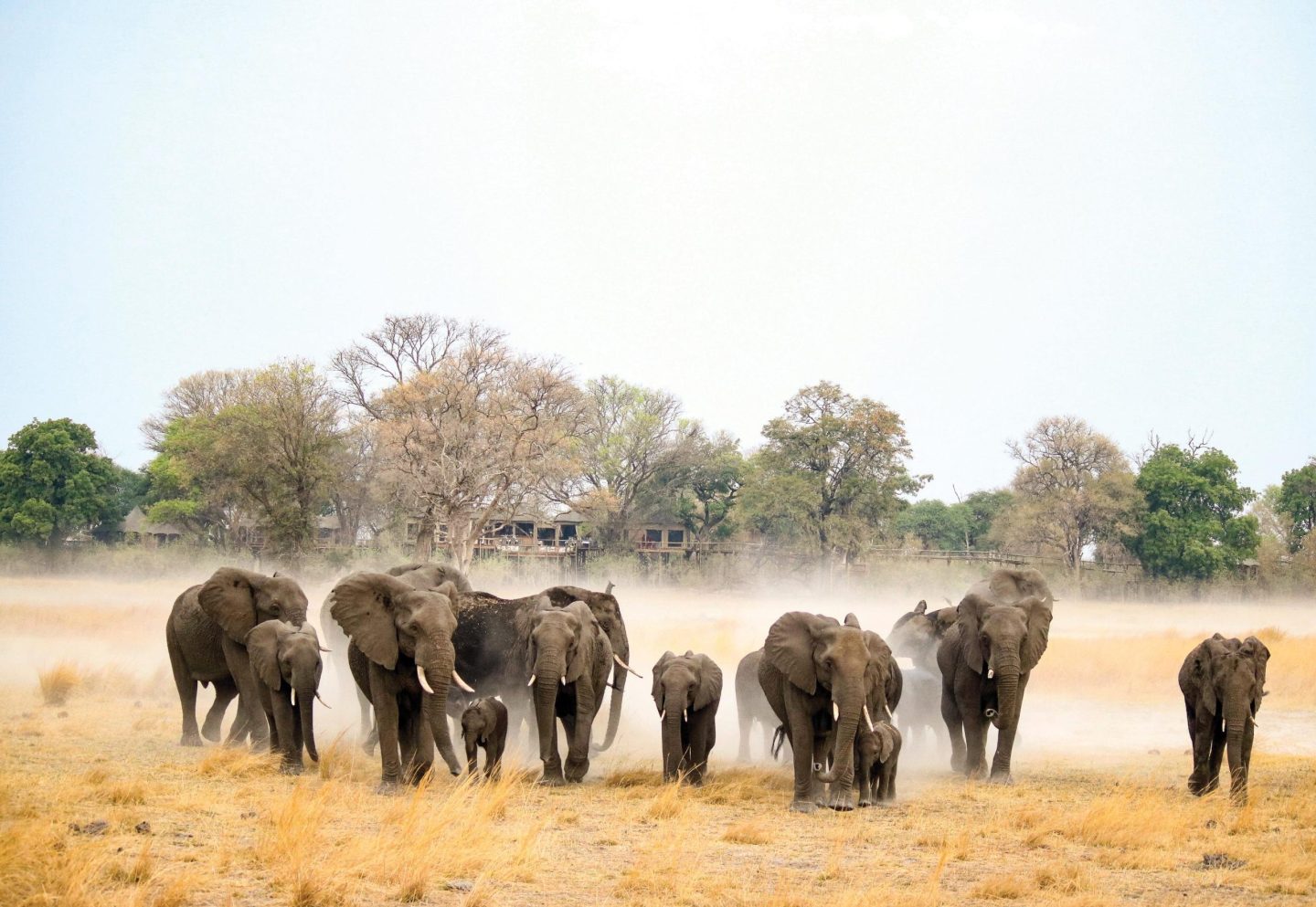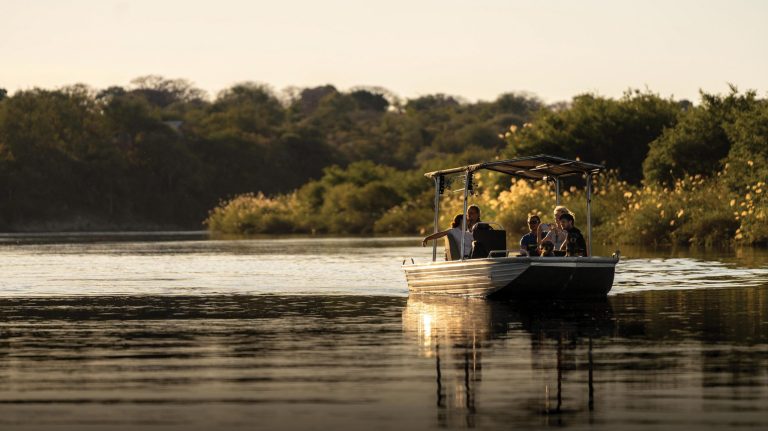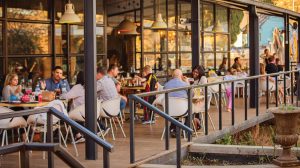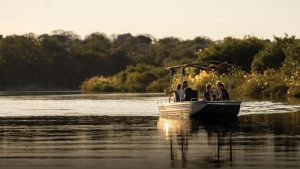
Droombos Estate
Just minutes from Windhoek and yet worlds away from its pace, Droombos Estate has become synonymous with refined hospitality and

The sky was gold, deep orange and bright yellow – surreal, as though painted that morning by a hand in the sky with fresh, glistening oil paints. This land I had travelled to is part of my country, and yet it felt like another world entirely. What makes the light seem so different here?
And then, just as I was searching for the right words, the sun broke over the horizon – a giant, glowing red sphere of promise. The promise of a new day. The sun’s red dwarfed the orange sky before it, and, as if the crescendo of a symphony was playing in the background, it all gave way to the more subdued colours of the day. Pastel blues, purples and lilacs now swept the edges of the skyline. Another morning where colour danced visibly to the inaudible symphony of life. Another perfect morning in Africa. And this morning, I was perched high in the trees of Bwabwata National Park, at Nambwa Tented Lodge.
Bwabwata is one of Namibia’s most ecologically and culturally unique protected areas. It is a crucial corridor for large herds of elephants that move seasonally between Angola, Botswana and Zambia – part of an ancient migratory rhythm. Bwabwata takes its name from a small village within the park. It means “the sound of babbling water” – a fitting name, as this place does not shout for attention; it flows around you, constant and alive.
The Horseshoe Bend on the Kwando River is one of the park’s most iconic locations, known for its serene, sweeping beauty and dense gatherings of elephant. But it is not just about elephants. The park supports more than 35 large and medium-sized mammals – including buffalo, lion and leopard – and over 450 species of birds have been recorded here.
Just reaching this part of the world feels like a journey into something rare. Accessible only by 4×4, the road into this stretch of Bwabwata National Park winds through thick river sand and forested wilderness – a thrilling prelude to the seclusion that awaits.
There are places that don’t just welcome you; they envelope you. Nambwa Tented Lodge is one of them. Built on raised wooden platforms, the camp hides in the trees. Elevated walkways meander through the riverine forest, and the canvas suites blend into the canopy. Below, life moves as it always has… Elephants pass silently beneath, hippos snort at the river’s edge and leopard tracks mark the sand.
To stay at Nambwa is to tune in to a lullaby of wilderness. By day the treetops fill with birdsong. At night a lion calls so close that it resonates in your bones. The suites themselves are stunning: vast and luxurious, with crisp white linen, private lounges for reading and reflection and deep bathtubs perfectly positioned to watch wildlife in the Kwando River below. It is the kind of place where doing nothing becomes an immersive experience.
Mornings begin with rich, earthy coffee from Two Beards, roasted specially for African Monarch Lodges. It tastes best on the deck while wildlife wander in the distance. Game drives lead you through thick vegetation to Horseshoe Bend, where red lechwe leap across the water, their spray glistening in the morning light.
Evenings unfold at a slower rhythm. Giraffes silhouette against a pink sky, and a crisp Namibian craft gin, infused with local botanicals, marks the end of the day. Toasting the land with its own flavours – there is something grounding in that.
And then there is the food – easily the unexpected highlight of your stay. Fresh and thoughtful, each dish is masterfully balanced across four courses, with subtle threads linking each plate to the next. These connections are barely noticeable, but together they create a quiet symphony of decadence. From the delicate amusebouche to the elegant desserts, the journey is seamless and unforgettable. The food alone may just convince you to return, even if you never spot a single elephant.
We travelled as a family, our young child in tow, whose eyes lit up with delight at the idea of staying in a real-life treehouse connected by wooden walkways – the stuff of dreamy imagination. Though too young for the full Junior Ranger Programme, we were heartened to discover Nambwa’s thoughtful, child-friendly approach. For slightly older children, the lodge offers immersive safari experiences that mix conservation education with playful discovery. It is a place where even young travellers can forge deep connections with the wild.
But Nambwa is more than scenery. It is a sanctuary – for wildlife and for the people protecting it. As part of the African Monarch Lodges portfolio, Nambwa was built with the intention of offering extraordinary safari experiences while contributing meaningfully to conservation and community empowerment. A defining part of this commitment is that 12% of Nambwa’s revenue, before any deductions are made, goes directly to the Mayuni Conservancy – the community living adjacent to the park. Their role is not symbolic, but central to the lodge’s ethos. All general staff working at Nambwa are from the Mayuni Conservancy, and their stories reflect the deep impact of this partnership. One that stayed with us was that of the sous-chef, once a scullery worker who used to watch the kitchen team through the window while washing pots and pans. His quiet passion caught the chefs’ attention, and they began training him. Today, he not only helps prepare exquisite meals but personally introduces the menu to guests from around the world.
That sense of connection is what makes Nambwa feel so rooted. You are not just a guest here; you become part of a living, breathing ecosystem built on mutual respect between people and the planet. There is a clarity here – not just in the air, but in how life itself feels. These wild corners remind us of a fundamental truth: we do not need more things; we need more connection. Good food, good people and a fire shared under stars can nourish the soul far more than we often admit. TN
africanmonarchlodges.com | reservations@africanmonarchlodges.com

Just minutes from Windhoek and yet worlds away from its pace, Droombos Estate has become synonymous with refined hospitality and

There’s a stretch of Namibia where time slows to the gentle rhythm of river flow – where the land hums

In a country defined by vast horizons and staggering biodiversity, Birds of Namibia – A Photographic Field Guide emerges as

Just minutes from Windhoek and yet worlds away from its pace, Droombos Estate has become synonymous with refined hospitality and

There’s a stretch of Namibia where time slows to the gentle rhythm of river flow – where the land hums

In a country defined by vast horizons and staggering biodiversity, Birds of Namibia – A Photographic Field Guide emerges as